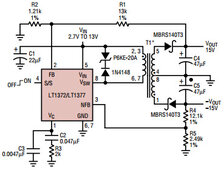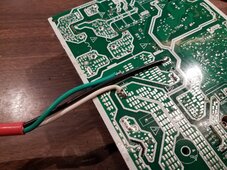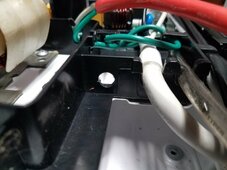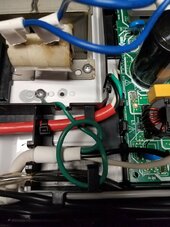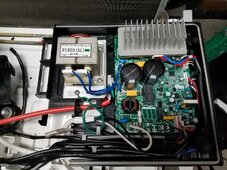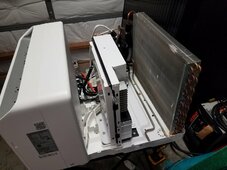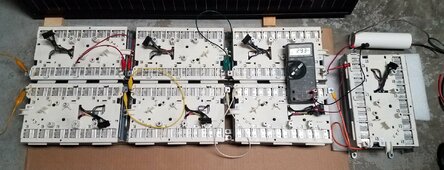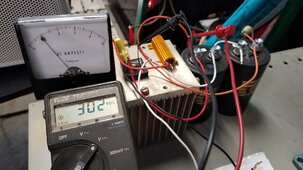You are using an out of date browser. It may not display this or other websites correctly.
You should upgrade or use an alternative browser.
You should upgrade or use an alternative browser.
Midea U 12k power from DC (IT WORKS!!!)
- Thread starter AntronX
- Start date
Powered it back up from AC power. At 120vac DC voltage was 333v with only 11w fan load. With compressor on low speed around 260Wac DC dropped to 303v. Power factor was 0.7 It ran without change down to 100Vac and 250Vdc. At around 220Vdc condenser fan motor spun up fast but compressor speed remained same. Increasing voltage also increased condenser fan speed until it settled back down to slow speed at 250Vdc. In fan only mode I increased input voltage to 132Vac which produced 361Vdc on the caps. No errors reported. So it seems that usable DC voltage range is at least 250 - 360Vdc. I did not go further than this range to play it safe for now. I guess DC powered test is next.
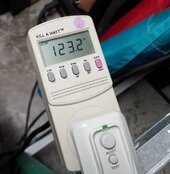
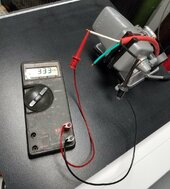
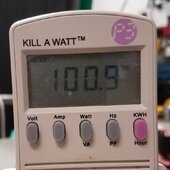
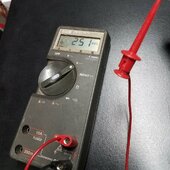
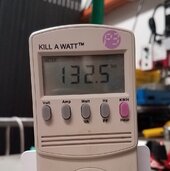







Last edited:
Consumerbot3418
Fitting square pegs into round holes... for fun?
I've got one of these units sitting on a shelf--seems to have leaked its refrigerant, as it gradually did a worse and worse job of cooling. Happened under warranty, so I got a refund from Midea. Kinda glad, cause my inverter hated it! Horrible LED flicker that was eventually traced to this thing.
@AntronX , If you need another board for whatever reason, let me know. I was planning to scrap this unit, after salvaging the motor, transformer, heat sink, caps, etc.
@AntronX , If you need another board for whatever reason, let me know. I was planning to scrap this unit, after salvaging the motor, transformer, heat sink, caps, etc.
Sure, Thanks! I will take that board and other parts you may have. I may want that compressor as well.@AntronX , If you need another board for whatever reason, let me know. I was planning to scrap this unit, after salvaging the motor, transformer, heat sink, caps, etc.
RCinFLA
Solar Wizard
- Joined
- Jun 21, 2020
- Messages
- 3,574
I don't think you will ever find an active power factor correction on a 120vac variable speed inverter A/C. With the low frequency 3 mH choke the power factor will be 0.80 to 0.85 range varying with compressor speed load. The low freq filter inductor is necessary to avoid randomly popping a 120vac branch 15 amp breaker on peak current with a 12-14kbtu unit.
The voltage on output of choke and on the filter capacitors will be about 165vdc peak with about 10-20v of 120 Hz ripple voltage depending on compressor speed loading.
There may be some other smaller power supplies that require 120vac input to run relays, reversing valve, and thermostat.
The voltage on output of choke and on the filter capacitors will be about 165vdc peak with about 10-20v of 120 Hz ripple voltage depending on compressor speed loading.
There may be some other smaller power supplies that require 120vac input to run relays, reversing valve, and thermostat.
Nope, it all runs on 340Vdc internally. Unless I missed something then I will find it where the smoke comes out.There may be some other smaller power supplies that require 120vac input to run relays, reversing valve, and thermostat.
Last edited:
On slowest speed total power consumption is 316V * 0.34A = 107 watts. Outlet air temp is 57F and intake is 72F. With 95% efficient 12v to 316V dc-dc converter you could run it on 12V LFP battery with only 9 amps. Perfect for vans or camping.
RCinFLA
Solar Wizard
- Joined
- Jun 21, 2020
- Messages
- 3,574
Was just drawing that up. Actually, it is two half wave rectifiers to produce twice the voltage.
Be careful because each DC supply terminal will have voltage to ground bonded AC neutral.
The whole inverter/compressor is floating, other than metal case ground.
They are likely doing this so they can use the same compressor and inverter as 230vac European mini-splits.
You likely draw about 10 amps from 120vac at full speed with a power factor about 0.8, but it is peak current crest factor that hurts.
The surge resistor likely has a bypass relay once caps are initially charged. 2000 uF without surge limiting would blow breaker every time and saturate the inductor likely magnetically biasing the filter inductor core from the large surge current.
Once it is plugged in to 120vac outlet the HVDC likely stays live whether unit is running or not.
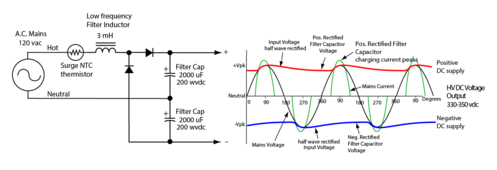
Be careful because each DC supply terminal will have voltage to ground bonded AC neutral.
The whole inverter/compressor is floating, other than metal case ground.
They are likely doing this so they can use the same compressor and inverter as 230vac European mini-splits.
You likely draw about 10 amps from 120vac at full speed with a power factor about 0.8, but it is peak current crest factor that hurts.
The surge resistor likely has a bypass relay once caps are initially charged. 2000 uF without surge limiting would blow breaker every time and saturate the inductor likely magnetically biasing the filter inductor core from the large surge current.
Once it is plugged in to 120vac outlet the HVDC likely stays live whether unit is running or not.

Last edited:
I think so too. Beautiful drawing you made. What software it that?They are likely doing this so they can use the same compressor and inverter as 230vac European mini-splits.
RCinFLA
Solar Wizard
- Joined
- Jun 21, 2020
- Messages
- 3,574
Adobe Illustrator.I think so too. Beautiful drawing you made. What software it that?
RCinFLA
Solar Wizard
- Joined
- Jun 21, 2020
- Messages
- 3,574
You could run two 165 vdc batteries with common neutral-ground connections of opposite 165 vdc battery polarities. A slight bit safer as you only have to worry about touching one lead of each battery.
About as dangerous as a high voltage PV array.
About as dangerous as a high voltage PV array.
I am thinking to leave both positive and negative floating in reference to ground and use isolation monitor instead. This way if I come in contact with one wire I will not feel any shock but isolation monitor should pick it up and shutoff power.
That's what I observed in my test from day before. DC caps stay live as long as 120Vac is present.Once it is plugged in to 120vac outlet the HVDC likely stays live whether unit is running or not.
zanydroid
Solar Wizard
There is a 350V rail inside any 240V AIO. Does that count?Nice work ! Are there practical 12V or 24V to 280V boost converters? Hmm I'd love to run my 230VAC mini split on direct 24V DC someday
Thanks! Not that I am aware of anything practical. There are dc-dc boost modules on aliexpress but definitely not something plug and play.Nice work ! Are there practical 12V or 24V to 280V boost converters?
As long as it stays below 360V i guess you could tap hvdc bus from one of those inverters. But some of them like the Growatt 5000es have 450v bus that may be too high for this air conditioner.There is a 350V rail inside any 240V AIO. Does that count?
zanydroid
Solar Wizard
Got it. Well if someone is going to do this surgery they should test first and ask aroundAs long as it stays below 360V i guess you could tap hvdc bus from one of those inverters. But some of them like the Growatt 5000es have 450v bus that may be too high for this air conditioner.
I’m not sure if there is value to tapping HVDC vs using the inverter output. My idea was: what is the most basic bitch, mass market device with such a boost converter of this size.
Maybe if one can turn off the AC load search and save some power. Also maybe the boost converter reacts better to load changes than boost + inverter.
Tapping dc bus allows for slightly higher efficiency and avoiding issues like flickering lights. A suitable AIO unit will have to be tested and potentially firmware modified. But my goal is 350Vdc loads in the house like inverter based air conditioners, instant water heaters coupled directly to 350Vdc battery which is powered by high voltage DC rooftop solar strings. For cooking I think I can use 240Vac powered induction cook tops that must be also rectifying 240Vac up to 340 - 400Vdc. This way most high power loads in the house are kept on hvdc avoiding the need for big and expensive 48v to 120/240v inverters. And added benefit is redundancy since there is no inverter.I’m not sure if there is value to tapping HVDC vs using the inverter output.
zanydroid
Solar Wizard
One thing I’d love to know from this is how it affects the noise signature from the induction.For cooking I think I can use 240Vac powered induction cook tops that must be also rectifying 240Vac up to 340 - 400Vdc.
I believe you get kHz multiplied with 60hz or 120hz by default (I don’t think they do any smoothing)
But with DC in you would only have the kHz component.
So would it sound better?
(I’ve resigned myself to buzzing on induction).
It would be silent if PWM frequency is above human hearing upper frequency limit. But I never tried induction cooktop before. I may get one of those table top single burner units to experiment with.So would it sound better?
Similar threads
- Replies
- 1
- Views
- 220
- Replies
- 11
- Views
- 888
- Replies
- 10
- Views
- 1K
- Replies
- 5
- Views
- 2K



